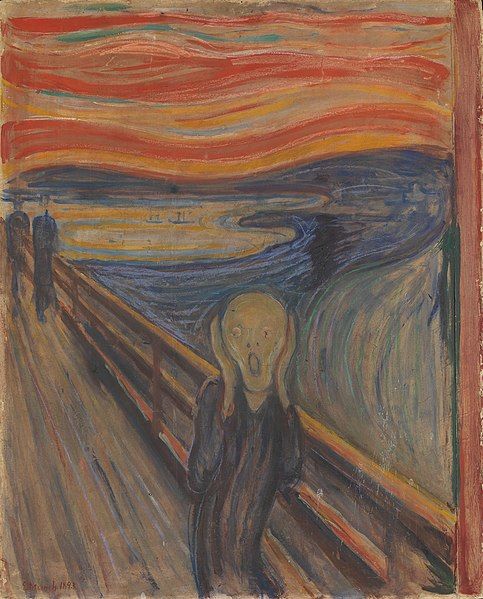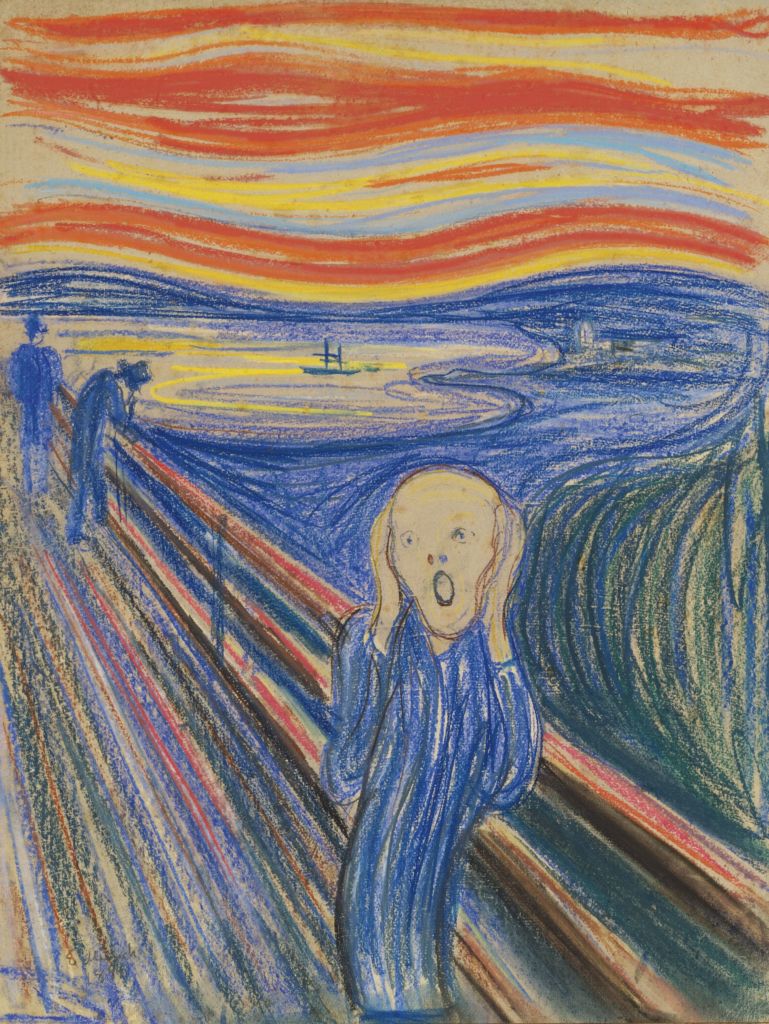The Scream is the English title given to a painting conceptualized and created by Edvard Munch, an expressionist in Norway, in 1893. The artwork is famous for the “shrieking expression” of the depicted figure at the bottom, which seemingly saw something shocking at the lower-left corner of the painting. While there are several theories surrounding the meaning of the artwork, some of the most famous interpretation includes the depiction of anxiety and the fragility of the human condition. To know more about the inspiration of the artwork, as well as its value in the art industry, here is an introduction to The Scream.
Origins and Interpretations
According to Munch in his diary entry that was dated “January 1892,” he was walking along a path wherein the city is on the other side while a fjord is on the other. While he was walking, he suddenly felt tired and stopped to look at the fjord. As he gazed into the view of the fjord, he saw the clouds are turning blood red as the sun sets. During the moment, he thought that he heard a scream, and the scream must have been brought by nature. He then got the idea for a painting where the clouds are blood red, and a human figure is seen screaming at the front of the artwork.
Like the interpretation of the artwork’s meaning, there are also theories surrounding what made the clouds have a blood-red color when Munch saw it in 1892. The most popular theory about the clouds is that it was the volcanic eruption on the island of Krakatoa that tinted the clouds and the skies blood-red during sunsets. However, the eruption happened between 1883 and 1884, which means that it occurred years before Munch painted The Scream. Some experts say that the Krakatoa theory cannot be plausible since Munch is described as an artist who doesn’t take sceneries literally, thus making it seem like it was only in Munch’s imagination that the skies turned blood red.
When the Krakatoa theory was debunked, some formulated a new theory wherein it was the nacreous clouds that Munch saw on that particular day. Nacreous clouds are known for their colored interference fringes, which could often turn into different shades of red and orange during the afternoon. In addition, the appearance of the nacreous cloud in real life bears a striking resemblance to the clouds painted by Munch in The Scream.
The screaming figure that is sometimes interpreted to be in a “deranged” state is said to have been inspired by the people in the lunatic asylum that located near the fjord where Munch saw the blood-red clouds. Furthermore, the screaming figure may have also been inspired by Munch’s sister, who was admitted to the same mental asylum for having bipolar disorder.
Alongside the asylum inspiration, the genderless figure could be inspired by the Peruvian mummy, a peculiar mummified human that was seen by Munch when he visited the Exposition Universelle of 1889 in Paris, France. The Peruvian mummy is said to have been buried in a fetal position, wherein its hands are placed directly at its ears.
Versions and History of Theft
Edvard Munch has created four versions of The Scream, with two created using paint while the other two were in pastels. The first version that was painted was the first known rendition of The Scream and is displayed at the National Gallery of Norway in Oslo. The second version of The Scream, which is a pastel, was revealed in 1894, and it was believed to be a draft of Munch to visualize what the final rendition of The Scream would look like. This pastel version is currently in the Munch Museum in Oslo, Norway. The third version, another pastel, was released in 1895 and was sold for more than $199 million at the Sotheby’s Impressionist and Modern Art auction on May 2, 2012. According to Leon Black, a financier and art collector who bought the third version, it was the most vibrant and colorful rendition of The Scream. The fourth version, also known as the second painted version, was created in 1910 by Munch, who was revisiting his old artworks. The said version is also in the Munch Museum, like the first pastel version.
Two versions of The Scream were stolen in different years, specifically in 1994 and 2004. The first theft happened at the National Gallery of Norway, wherein two thieves stole the first painted version of The Scream when almost everybody was busy watching or organizing the 1994 Winter Olympics. After stealing the artwork, the two thieves left a note near the painting’s original location, saying thanks for the poor security at the gallery. The thieves first asked for a $1 million ransom for The Scream, but the administration of the gallery refused. The Norwegian police, along with the British police, then set up a sting operation to capture the two thieves. The operation was successful, and the authorities were able to recover the first painted version of The Scream on May 7, 1994.
The second theft happened on August 22, 2004, when a group of armed individuals forcefully stoles the 1910 version of The Scream in the Munch Museum. Besides The Scream, the armed robbers also stole another Munch artwork called Madonna. A thief who was with the group during the said theft was arrested on April 8, 2005; however, the Norwegian police still have no leads on where the paintings are. They then arrested three more individuals in the same year, but no one could still point out the location of the paintings. The authorities then posted a reward of two million Norwegian kroner to whoever could give leads as to where the 1910 version of The Scream and the Madonna are hidden. Thankfully, the two stolen paintings were recovered on August 31, 2006, although each of them had minor damages. The two paintings were restored soon after, and it was displayed publicly again on September 27, 2006, at the Munch Museum. You may also read our article, Which Famous Paintings Have Been Stolen? for more information about other stolen paintings.


